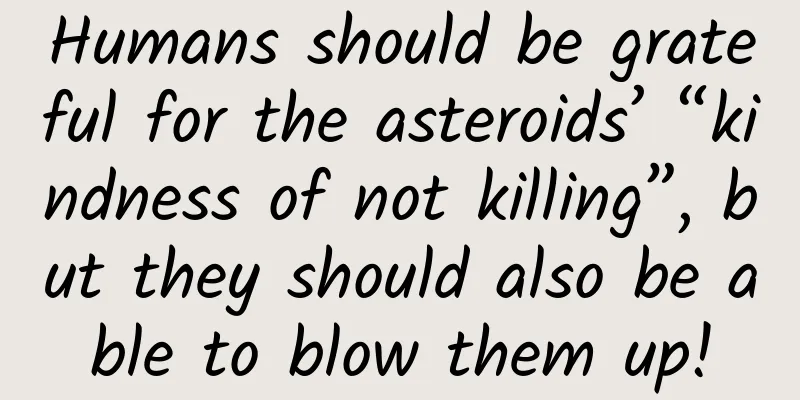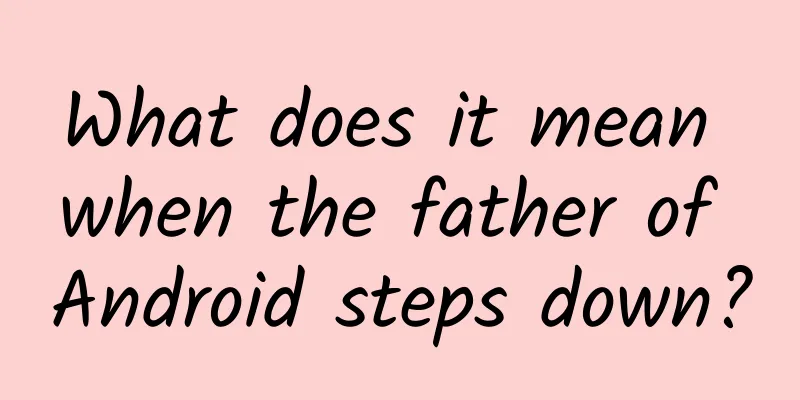Humans should be grateful for the asteroids’ “kindness of not killing”, but they should also be able to blow them up!

|
Not long ago, a somewhat sci-fi news became a hot topic. Wu Yanhua, deputy director of the National Space Administration, said that my country will start to establish a near-Earth asteroid defense system... To truly respond to the threat posed by asteroids and extraterrestrial objects to our home planet in the future, and to truly make new contributions to China. From Weibo CCTV Military So, what are near-Earth asteroids? What threats do they pose to our home planet? How can we eliminate their threats? Let's talk about this today! 01 Thank you for not killing me The so-called "near-Earth asteroids" are asteroids whose orbits intersect with the Earth's orbit, or may intersect with the Earth's orbit in the future after being perturbed by the gravitational pull of a planet. You should know that there are no traffic lights, traffic police, or switchmen in the solar system. If these asteroids intersect with the Earth's orbit, there is a risk of them hitting the Earth head-on. (For the sake of simplicity, when we talk about "asteroids" and "small celestial bodies" below, we also include the nucleus of a comet, after all, it and "asteroids" are similar in their damage to the Earth.) Small Solar System Objects Known as of January 2018 Small objects in the main asteroid belt are marked in brown, and near-Earth objects are marked in cyan The Earth's orbit is grayish white, which is the third circle from the inside to the outside. Image source: NASA Some friends may think that the universe is so big and asteroids are so small, the possibility of them hitting the earth must be very small, right? But the opposite is true. For example, we have all ridden in a car and have surely experienced the sound of raindrops hitting the car windows on a rainy day. If the earth were a car, on the lane revolving around the sun, the windows of the earth would also keep crackling, but the things hitting them would not be raindrops. Tuchong Creative It is estimated that 25 million meteoroids of all sizes enter the Earth's atmosphere every day. Cumulatively, the total amount is about 15,000 tons per year. The reason you can still read this article on your phone is that, thankfully, most meteoroids are very small. The vast majority of meteors that can be seen are caused by small objects the size of sand or green beans, and their sparrow tactics usually do not cause serious consequences. However, "meteoroid" and "asteroid" are just human classification terms, and there is no clear boundary between them. If a "meteoroid" is big enough, it may hit the lower atmosphere or even the ground, causing a major disaster. Here are some of the more famous ones: On the morning of February 15, 2013, a fireball streaked across the sky over Chelyabinsk, Russia, outshining the rising sun. The fireball left a 10-kilometer-long trail of smoke and dust in the sky, and the unburned meteorite smashed a 6-meter-wide hole in the frozen Chebakul Lake. More than 7,200 houses were damaged by the shock wave of the fireball explosion, and 1,491 people were indirectly injured. It is estimated that the fireball event in Chelyabinsk was caused by an asteroid with a diameter of 17 to 20 meters. In history, larger celestial impacts are not far away. On June 30, 1908, in Russia, a huge explosion occurred in the sky above the Tunguska River. The shock wave shattered windows within a radius of 650 kilometers, burned and felled 80 million trees over an area of more than 2,150 square kilometers, and the pressure recorders in the UK detected the pressure fluctuations caused by the explosion. The scientific community now generally believes that the cause of the Tunguska explosion was a rocky asteroid with a diameter of about 65 meters. An example of a meteorite crater | TuChong Creative The most famous asteroid impact site is probably the Chicxulub crater in Mexico. About 66 million years ago, an asteroid with a diameter of at least 10 kilometers hit here at a speed of 20 kilometers per second, which opened the prelude to the Cretaceous extinction event. 75% of the species on Earth, including all non-avian dinosaurs, bid farewell to the stage of life on Earth forever in this extinction event. So from this perspective, humans can develop to this day perhaps thanks to the asteroids’ “kindness of not killing”. 02 How powerful is the impact? I'm afraid you can't write one line. As mentioned earlier, a 10-kilometer-class asteroid caused a mass extinction. You may be wondering: How could a stone of only 10 kilometers, which is the size of a city, bring disaster to a world with a surface area of 500 million square kilometers? Tuchong Creative Don't forget that this rock is 10 kilometers high - more than a thousand meters higher than Mount Everest. When such a huge mountain hits the ground at high speed, we can use the kinetic energy formula to calculate the energy it carries (the process of combining formulas is omitted): This energy ≈ density × diameter³ × speed²÷3.82 Fill the data into the formula one by one, all in the standard units of the International System of Units. The average density of carbonaceous chondrites is 3300 kg/m3, the diameter is 10,000 meters, and the speed is 20,000 meters/second. You will see that this formula calculates the product of the squares and cubes of various thousands and millions of joules, and the final result is about 346,000,000,000,000,000,000,000,000 joules - the first three digits of the scientific community's estimate of this impact are 420, but the order of magnitude is the same, a 24-digit number (you can see that there is indeed no line written down↓↓↓). 420,000,000,000,000,000,000,000,000 Joules What does this mean? It is equivalent to the total energy produced by the core of the sun every millisecond, or the energy released by the explosion of 2 million Tsar hydrogen bombs. If the 500 million square kilometers of the earth's surface were evenly covered with 2 meters of water at 0°C, then this energy would be enough to boil all the water. Fortunately, the impact energy will be concentrated at the point of impact, which will completely vaporize the asteroid and create a huge crater 100 kilometers wide and 30 kilometers deep on the spot, instead of spreading all the energy to the entire earth at once. But don't be too happy too soon, the law of conservation of energy determines that it is only a matter of time before everyone dies, because the impact of the impact will come late but soon... Starting from the impact point, there are winds with speeds of 1,000 kilometers per hour and tsunamis with waves as high as 1,500 meters. In addition, 25 trillion tons of matter will be thrown into the sky in an instant, some of which will splash into space and never come back, while the rest will fall back to the earth and ignite again when they re-enter the atmosphere, and the firestorm will sweep the world. Tuchong Creative The large amount of dust produced by the impact and the ash caused by the combustion will be suspended in the atmosphere, blocking the sunlight for a long time and hindering the photosynthesis of plants. The ecosystem will collapse and consumers at all levels in the food chain will die one after another. The Earth has been tortured so badly by this, will there be peace in the future? The attitude of the asteroids is naturally: I was wrong, I will do it again next time. 03 Humans must not rely solely on the "grace of not killing" from asteroids Although no asteroid has yet dealt a fatal blow to humans, we really can't rely on luck in this matter. According to NASA estimates, approximately every 5,000 years, an asteroid larger than 140 meters will collide with the Earth. On July 25, 2019, an asteroid temporarily numbered 2019 OK flew by the Earth at a distance of 72,000 kilometers, less than one-fifth of the distance between the Earth and the Moon. Isn't it terrifying to be so close? What's even more terrifying is that it was not discovered by humans until the day before the flyby! On April 13, 2029, the asteroid 99942, also known as "Apocalypse," with a size of 170 to 450 meters, will fly past the Earth at a distance of about 32,000 kilometers. This distance is already lower than the synchronous satellite orbit! Humans pride themselves on being intelligent creatures, but it would be disheartening to think that if faced with an asteroid strike, they would die as miserably as the illiterate dinosaurs. In order to avoid being blinded by asteroids, we must first know how many there are and where they are hiding. The sooner we discover them, the better. Since nearly 30 years ago, several near-Earth object monitoring projects have been launched, with an average of 40 discovered per week, which is a fruitful harvest. The number of discoveries by each NEO monitoring project Image source: NASA Why did Deputy Director Wu say that we need to establish a ground-based and space-based monitoring system? Isn't ground-based observation enough? It is indeed not enough. Some asteroids come under the cover of the light of bright celestial bodies, such as the Chelyabinsk asteroid, which came from the direction of the sun. If you want to discover it in advance, you have to look at the stars during the day, so no one knows about its arrival in advance. Another example is the very unlucky 2019 OK (the asteroid number mentioned above). It encountered a full moon during the days when it should have been visible. If the monitoring system is launched outside the atmosphere, then the bright disks of the sun and the moon will be right next to the dark space, and "looking for stars during the day" will be possible. So, if we get really lucky—or really unlucky—and do find an asteroid that's headed for Earth, how would we deal with it? 04 To be or not to be? Will not go gentle into that good night! Hollywood sci-fi disaster movies love to use the plot of asteroids hitting the earth. Movies like "Armageddon" and "The Last Airbender" have plots where humans try every means to blow up asteroids. The same is true in reality. Faced with the crisis of destruction, humans will never sit idly by. The good news is that there are already many feasible solutions. Once an asteroid is discovered that threatens the Earth, all possible options can ultimately be divided into two categories: disruption and pushback. Disintegration means splitting the asteroid into scattered individuals (mainly by explosion). The small celestial fragments flying in multiple directions will miss the Earth, or be small enough to burn up in the atmosphere. Pushing away means to deviate the asteroid's orbit as a whole, or to speed it up or slow it down, so that it arrives at the rendezvous point earlier or later, which also achieves the effect of missing the target. The diameter of the Earth's equator is 12,756 kilometers, and its orbital speed is 30 kilometers per second. It takes 425 seconds, or about seven and a half minutes, to travel one body length. The essence of pushing away is to buy 425 seconds for the Earth. There are several specific implementation methods: The most easily thought of is thermonuclear weapons. The large amount of heat generated by thermonuclear weapons can partially vaporize an asteroid, and use this temporarily generated gas to break up the asteroid, or eject material to push the main body off orbit. But be careful, if the plan fails, what will hit the earth will not only be an asteroid, but also an asteroid with nuclear contamination. The cold weapon method is to launch an impactor to hit the asteroid to change its speed or direction. Or the non-contact method is to let a tractor fly with the asteroid, and the gravity will gradually pull the asteroid off its orbit. As the saying goes, "a slight error can lead to a great error." If the plan is implemented early enough, there is hope that the asteroid will miss the target. There are also many lesser ideas, such as sending a digging and projectile machine to the surface of the asteroid, constantly throwing the material on the surface of the asteroid into space, causing it to slowly disintegrate while letting the law of conservation of momentum help change the asteroid's orbit. Or using lasers or focusing mirrors to vaporize part of the asteroid's surface so that it is gradually pushed away by the ejected rock gas. And so on. In terms of the time it takes to take effect, it can also be divided into two categories: blitzkrieg and protracted warfare. Thermonuclear weapons or impactors are considered blitzkrieg, while gravitational traction, excavation ejection, and local injection are protracted warfare. However, no matter which method is used, it needs to be discovered in time and arranged as early as possible. NASA's most optimistic estimate is a preparation period of 5 to 10 years, and it is currently implementing an impact experiment on the asteroid 65803 Didymos, which is expected to be completed in late September/early October 2022. Deputy Director Wu proposed to conduct a technical experiment in 2025 or 2026, which is very aggressive in terms of timetable. From Director Wu's words, we can read that the implementation plan is impact, but I don't know which asteroid we will choose? Finally, let me talk about something that everyone likes to hear. Although when people talk about a small celestial body hitting the earth, they tend to think of it as a "natural disaster", occasionally some people will become very rich because of it (of course, don't be at the scene when the collision occurs...). For example, in Germany, there is a small town called Nördlingen, with a population of less than 20,000, located in a huge pit with a diameter of 25 kilometers and a depth of about 100 to 150 meters. At first, scientists thought that this pit was a crater, but later they found coesite, which can only be formed under high-speed impact, indicating that this was an impact crater formed by an asteroid with a diameter of 1,500 meters 15 million years ago. The impact and high temperature formed an estimated total of 72,000 tons of impact diamonds. Unfortunately, these diamonds were very small, with the largest not exceeding 0.2 mm. They were mixed in the soil and were inadvertently used by the builders of this city to build roads, walls and houses. Therefore, in terms of "diamond content", this town is really rich. Author | Qu Jiong, a popular science writer, has published works in the National Museum, the National Space Administration, etc. Review | Liu Xi, researcher at Beijing Planetarium, science film director and writer Editor | Ding Zong This article is produced by the "Science Rumor Refutation Platform" (ID: Science_Facts). Please indicate the source when reprinting. The pictures in this article are from the copyright gallery and are not authorized for reproduction. |
<<: Doctors urgently remind you that crayfish cannot be eaten like this!
>>: Most animals cannot recognize themselves in the mirror, so why can humans?
Recommend
.NET is open source, Visual Studio starts to support Android and iOS programming and comes with an Android emulator
At the Connect() conference held early this morni...
Remembering! The backbone of China
In the year 2021, which is about to pass, 27 acad...
How to play with Tik Tok’s recommendation rules?
How to create a hit on Douyin? What are the six m...
With its performance plummeting, will Nikon become the next Kodak?
In the 1970s, American imaging giant Kodak invente...
This feature of Huawei's new flagship is super powerful!
Last night Beijing time, Huawei held a press confe...
Alternative Pirates and Treasures TV version "Happy Pirates" first experience
Screen: operate: Sound Effects: Plot: Experience:...
Changan Automobile: In December 2022, Changan Automobile's new energy vehicle sales reached 45,200 units, a year-on-year increase of 202.21%
According to recent news, Changan Automobile rele...
It is said that Lin Daiyu pulled out a weeping willow tree. So what kind of willow tree did she pull out?
You may ask, Lin Daiyu was born weak and suffered...
Brand marketing promotion, how to make H5?
How to make H5? Based on my thoughts and ideas fr...
Experience the YunOS version of MX4. Alibaba makes Flyme even better
On October 21, Alibaba and Meizu jointly held a p...
It is reported that Great Wall plans to establish a new independent brand of new energy vehicles, focusing on SUVs and sedans
Recently, foreign media revealed that Great Wall ...
How to design a popular H5? 5 tips to make you a master!
It’s time to learn more. A few days ago, an H5 ad...
Is hybridization the reason why the Qinghai-Tibet Plateau became the "cradle of evolution"?
Qinghai-Tibet Plateau Have a complex Geological t...
[Children's Programming] "Yuanfudao Programming" L1+L2
[Children's Programming] Introduction to L1+L...
Safari and Firefox have both abandoned Flash, leaving Chrome with you
Adobe must have had a very unhappy couple of days...









